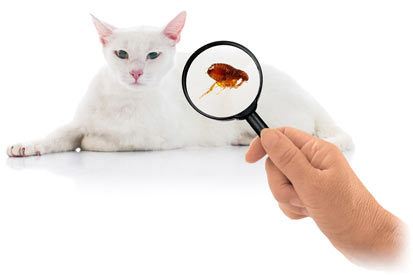Cat Fleas: Does My Cat Have Fleas?

Fleas in cats are a huge nuisance to humans and felines alike. You should always remember that fleas can actually cause several serious medical problems in your cat, as well. Take a look at this article to learn more about cat fleas, the illnesses they can cause, and the common cat flea control products.
It's critical to know that cats do not always scratch when they have fleas. That's an amazing thing to believe, but it's true. Cats may not scratch at all unless they are allergic to flea saliva. Therefore, it's important to know how to look for and find any fleas that may be on your cat.
First, Know Where to Look
Fleas can be very difficult to find. They are tiny, they move quickly, they can jump far, and they don't want to be found. There also may not be very many of them on your cat at any one time. They jump on and off or get groomed off by your very fastidious feline.
When you're looking for fleas on your cat, and you know fleas can be hard to find, it's best to start with the spots on your cat that fleas are most likely to be hanging out. These spots are the base of the tail and rump, under the chin, and on the belly.
Second, Know What to Look For
Since live fleas themselves can be tricky to locate, you'll want to have more than one search target. Luckily, fleas always leave something behind wherever they wander. Flea dirt. This is, less tactfully put, the pests' poop. It looks like small specks of black dirt, and if you were to touch it, it would feel sticky. While you are searching for fleas on your cat, be equally on the look-out for flea dirt.
You may be wondering how you can tell the difference between flea dirt and regular dirt if you find it on your cat. The best way is to place it on a white paper towel and spritz it with a little water. Then, press down and rub gently with your finger. If you see a red smudge, your search is over: your cat has fleas. The red smudge develops because flea dirt is composed of the digested remnants of the flea's diet: blood.
Third, Know How to Look
Fleas and flea dirt will both be down on your cat's skin, not on the fur. Parting the fur or pushing it backwards will allow you to see down to the skin. You can also use a flea comb like this one. This is a special comb with tines that are so close together that fleas can't squeeze through them. You may catch a live flea or dislodge some flea dirt by combing your cat all over with a flea comb. Placing your cat on top of a white cloth or a piece of paper while you hunt and comb will allow you to see anything that falls off of her.
Fleas are fast, and they can jump pretty far, so be ready with some soapy water to drop them into or be prepared to squish them pretty hard. Fleas are pretty tough.
Sometimes fleas can be especially hard to find on cats because our feline friends are such careful groomers. Talk with your veterinarian about whether your cat should be on routine flea preventative.
Here is a great video from VetVid on how to find fleas on your animal (they use a dog as a model, but the process is the same).
You May Also Like These Articles:
Bubonic Plague: Cats are Highly Susceptible
How to Be Prepared for Your Cat's Veterinary Bills
How To Take Your Cat To The Vet
Notice: Ask-a-Vet is an affiliated service for those who wish to speak with a veterinary professional about their pet's specific condition. Initially, a bot will ask questions to determine the general nature of your concern. Then, you will be transferred to a human. There is a charge for the service if you choose to connect to a veterinarian. Ask-a-Vet is not manned by the staff or owners of CatHealth.com, and the advice given should not delay or replace a visit to your veterinarian.





